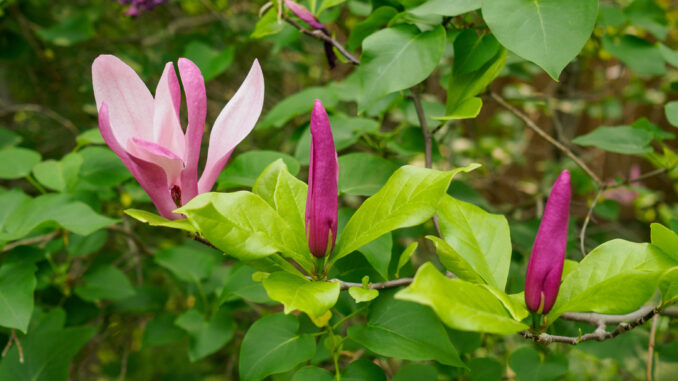
These warm summer days at home are an opportunity to discover aristocratic magnolias with unique, surprising colours. And to ensure that summer flowering plants continue into autumn, now is the time for some tender loving care.
Hardy magnolias in northern gardens
Magnolias are aristocrats among trees, legendary in southern regions and now hardy in the north. Best of all, their original tall and wide proportions have been scaled down, and new flower colours have been introduced for surprising effect in spring. In summer, their light and bright green foliage stands out against darker cedar and yew hedge backgrounds for season-long value.
A series affectionately known as ‘the girls’ (‘Ann’ ‘Betty’, ‘Jane’, ‘Judy’, ‘Pinkie’, ‘Randy’, ‘Ricki’’ and ‘Susan’) was bred by the U.S. National Arboretum to fit into small-garden venues. Their branch structure is reduced to small-scale, shrub-like trees from six to 18 feet in height, with increased cold tolerance and luxuriant flower display. Their blooms appear from prominent silver buds on bare branches carried through winter and opening two to four weeks later than the familiar Magnolia x soulangeana (recognized by its large, cup-shaped pink flowers). The later bloom schedule of the new series allows their flowers to avoid late spring frosts, and the trees will also open sporadic flowers throughout the summer months.
Flowers of these small-scale magnolia hybrids reflect their Magnolia lilliiflora genetics. The medium- to large-scale blossoms are moderately lemon scented, with narrow, strap-form petals requiring no need to sweep them up from lawns. Colours range from deep reddish-purple to pink-and-white, and include attractive bicolours. The trees prefer consistently moist organic soil amended with peat moss at planting time and will accept both full sun and partial shade. They are cold tolerant in hardiness zones four and five and, if purchased in a local plant nursery, they should be reliably hardy in your area.
The new low-scale magnolias cast almost no shade and carry multiple ornamental features useful in large gardens, where they can be pared to frame the corners of a structure, or arranged in a cluster of three on a broad, expansive lawn. In a small garden space, one magnolia can be the central feature underplanted with hostas or spreading sweet woodruff (Galium ordoratum) that will flower white in spring and stand green through 10 months of the year.
Colour surprises in other magnolia-breeding programs have found a new cutting edge with the introduction of yellow flowers. The pyramidal hybrid ‘Butterflies’ (zone five) is loaded with a fleet of bright yellow flowers bursting out from bare branches in mid-spring. The vibrancy of colour and chaotic blossom display draws attention in cool spring landscapes, especially when cardinals and blue jays sit on the branches in bright sun. Another yellow is ‘Elizabeth’ (zone five), with fragrant yellow flowers tinged yellow-green at the base and presented in regal display along extending branches. Just like true aristocrats, these magnolias are consistently attractive in every season.
Mid-summer rejuvenation for tired plants
There comes a point in early July when flowering annuals and perennial plants are tuckered out and flopping over with exhaustion. The garden has probably suffered through a few weeks of heat and drought, and plants that flowered exuberantly in May and June now don’t have enough energy to continue. This dive into exhaustion can easily be reversed with quick action to help plants revive for another generous display in August through to October.
Perennial plants flower, produce seed heads to complete their cycle and then stop flowering. Quickly removing the heads of spent flowers before seeds form can extend the blooming cycle with an additional two to four weeks in plants such as purple coneflower, rudbekia, liatris, coreopsis, butterfly weed and garden phlox.
Flowering annuals that arrived as perky box plants may now be sadly barren of flowers on long limp stems. Cut them back by 50 per cent of their length, and feed with a water-soluble fertilizer. Use a fertilizer formula with a higher middle number representing the phosphorus that promotes bud formation. Feed them a second time two weeks later, to promote new growth and buds that will carry through until the first frost.
Tea and shrub roses can be fed to encourage a late summer into autumn display, applying fertilizer preferably by the last week of July. Use a granular or water-soluble product, again with a higher middle number to encourage bud formation. (A fertilizer with balanced numbers, such as 10-10-10, is also acceptable.) Cut back only weak spindly growth, leaving sturdy wood to carry the next flush of buds. If possible, don’t cut back any cane growth in autumn when flowering has finished. Anchor canes to bamboo stakes and let them remain through winter, then remove dead wood in spring when fresh red buds are swelling. This will help to minimize cane loss.


